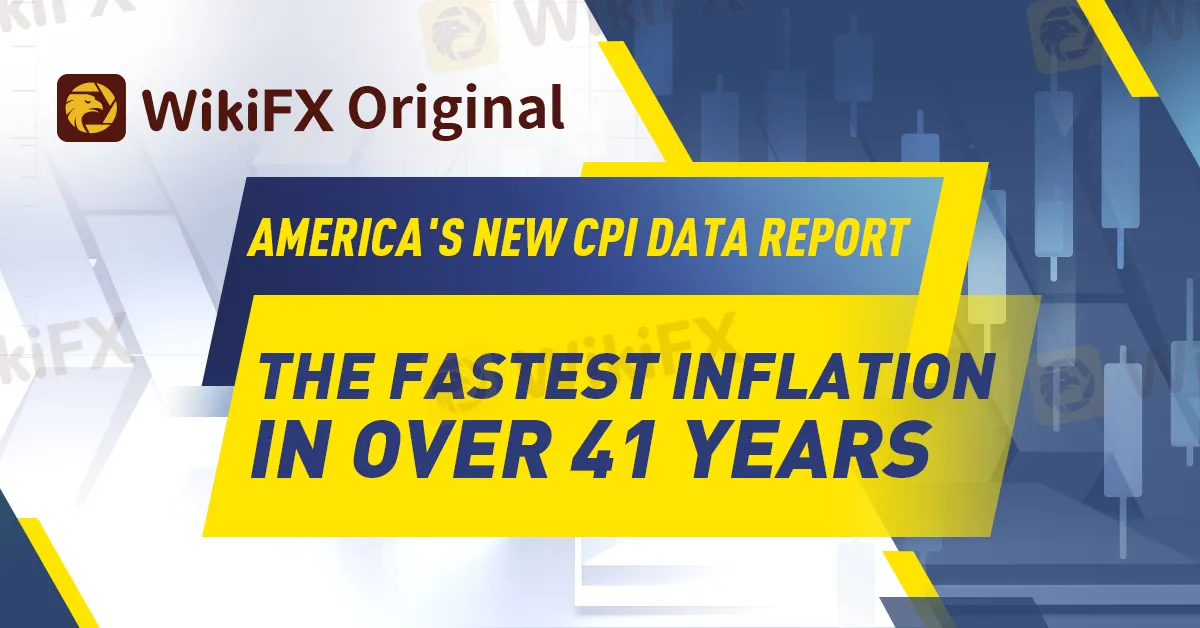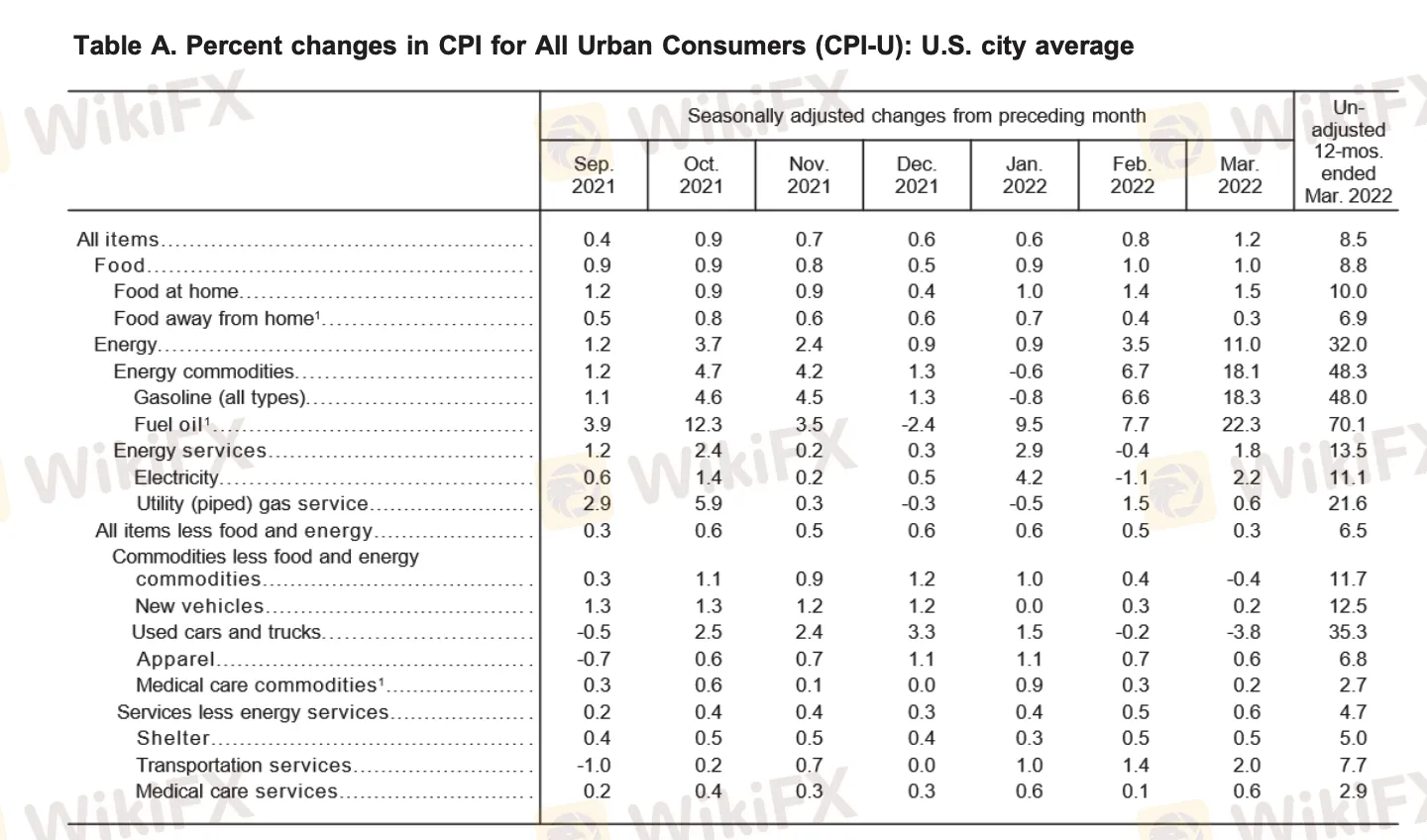简体中文
繁體中文
English
Pусский
日本語
ภาษาไทย
Tiếng Việt
Bahasa Indonesia
Español
हिन्दी
Filippiiniläinen
Français
Deutsch
Português
Türkçe
한국어
العربية
America's New CPI Data Report | The Fastest Inflation In Over 41 Years
Abstract:Last night at UTC +8 8.30 pm, the U.S. Department of Labour released its Consumer Price Index (CPI) data report. The CPI report for March reported a 1.2% increase after a 0.8% rise in the previous month. This figure lived up to the forecasted rate.

<WikiFX Malaysia Original: Editor - Fion>
Last night at UTC +8 8.30 pm, the U.S. Department of Labour released its Consumer Price Index (CPI) data report. The CPI report for March reported a 1.2% increase after a 0.8% rise in the previous month. This figure lived up to the forecasted rate.
However, the Core CPI m/m which was originally expected to remain at 0.5% (as highlighted in our Mondays article https://www.wikifx.com/en/newsdetail/202204116994539231.html), dropped to 0.3% instead. From a YoY standpoint, the total increment of the CPI data report in March is 8.5%, making it the fastest 12-month inflation pace since December 1981.

This new CPI report highlights the increasingly severe inflationary situation in the U.S. Energy prices, housing costs, and food prices had climbed significantly due to the Russian-Ukraine conflict as well as the supply chain disruptions with China combating a new wave of Coronavirus.
This CPI report also shows that, excluding the more volatile food and energy prices, core CPI rose 0.3%, which is equivalent to a 0.2 basis points rise in comparison to Februarys report. The YoY increase with this exclusion is 6.5%, making it the highest value since August 1982. This puts additional weight on American households, typically the low-income groups, now have to carve out more budget for their daily expenditures.

Extracted from the CPI March 2022 Data Report
As we break the components down of Americas CPI, we could see that energy prices jumped 11% with gasoline up by 18.1% and fuel oil up by 18.3%, which was a whopping 70.1% in terms of YoY.
According to the chief economist from Grant Thornton, one of the biggest accounting organizations in the world and America, oil price could be reaching its peak and it is time to divert our attention to another sector. A bigger problem lies within the rising prices of consumer goods and services. The increase in vehicle prices, typically the used cars and trucks that recorded a YoY increment of 35.3% could pose another issue for Americans too. If the supply chain issues persist, all these problems could become more severe.

Considering that the supply chain disruptions caused by the pandemic have not yet improved and the increase in U.S. consumer demand for services such as travel, the inflation rate is unlikely to fall back to the 2% inflation target set by the Federal Reserve in the near future.
At the same time, the risk of inflation dragging the U.S. economy into recession is building up. Economists predict that Americas economic activity may shrink as consumers gradually cut back on spending due to rising prices.
The market is now widely expecting a 50 basis points interest rate hike during the May FOMC meeting.
<WikiFX Malaysia Original: Editor - Fion>

Disclaimer:
The views in this article only represent the author's personal views, and do not constitute investment advice on this platform. This platform does not guarantee the accuracy, completeness and timeliness of the information in the article, and will not be liable for any loss caused by the use of or reliance on the information in the article.
Read more

Participate Now in ForexCup Trading Championship
FXOpen announced the trading competition called ForexCup Trading Championship 2025 for traders. You can join, trade, and compete for exciting prizes. Here are the details

What the Movie Margin Call Taught Traders About Risk and Timing
The 2011 film Margin Call offers a gripping portrayal of the early hours of the 2008 financial crisis, set within a Wall Street investment firm. While the film is a fictionalised account, its lessons resonate strongly with traders and finance professionals. For one trader, watching the film had a lasting impact, shaping how they approached risk, decision-making, and the harsh realities of the financial world.

Why More Traders Are Turning to Proprietary Firms for Success
Over the past decade, one particular avenue has gained significant popularity: proprietary trading, or prop trading. As more traders seek to maximize their earning potential while managing risk, many are turning to proprietary firms for the resources, capital, and opportunities they offer. In this article, we’ll explore why an increasing number of traders are choosing proprietary trading firms as their preferred platform for success.

Day Trading Guide: Key Considerations
How does day trading balance freedom and precision in fast-moving markets? Learn key strategies to navigate risks and seize intraday opportunities effectively.
WikiFX Broker
Latest News
Fake ‘cyber fraud online complaint’ website Exposed!
Day Trading Guide: Key Considerations
NAGA Launches CryptoX: Zero Fees, 24/7 Crypto Trading
Scam Alert: 7 Brokers You Need to Avoid
AvaTrade Launches Advanced Automated Trading Tools AvaSocial and DupliTrade
What Determines Currency Prices?
Why More Traders Are Turning to Proprietary Firms for Success
MC Markets Review 2025
How to Use an Economic Calendar in Forex Trading
T4Trade Enhances Forex Trading with Advanced Tools for 2025
Currency Calculator


